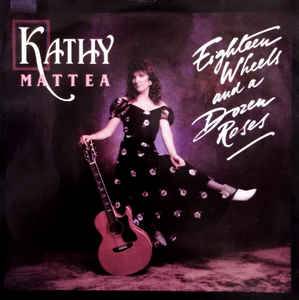Contrary to popular belief perpetuated by her late 1980s country music video, Kathy Mattea never met a soon-to-be-retired truck driver named Charlie at a truck stop, and she never autographed a photo for Charlie to give to his wife (we’ll refer to her as June) upon arriving home. Likewise, Mattea didn’t write a song inspired by this chance meeting — because the meeting never happened.
All this may be hard to digest for those who are familiar with the popular and lasting music video that accompanied the release of Mattea’s award-winning “18 Wheels and a Dozen Roses” on country radio in 1988.
Perhaps no song in country music history better highlights the gap between interpreting the lyricist’s meaning in a song and watching someone else’s interpretation play out on the screen. What a songwriter has in mind when composing may or may not be what the music-video producers have in mind when setting a song to film. In addition, what listeners interpret may be much more than the songwriter ever intended.
Kathy Mattea grew up in West Virginia, but music did not run in her bloodline. It wasn’t until college that she joined her first bluegrass band. After two years at the University of West Virginia, Mattea took what she’d learned from her campus band and headed for Nashville where, like so many others, her dreams of stardom turned into a journey of odd jobs. But unlike so many others, Mattea eventually received the opportunity to record demo tapes for other artists to consider when planning upcoming albums. After recording enough demos, Mattea’s voice caught the ear of a record executive. By 1983, she’d signed a contract with Mercury Records, and her first two albums enjoyed moderate success. But her 1986 album “Walk the Way the Wind Blows” brought the stardom Mattea had left college to find. A single from the album, “Love at the Five and Dime,” scored a Grammy nomination, and in the meantime, Mattea picked up a number of country music awards.
While the story of “18 Wheels and a Dozen Roses” may not have risen from a chance meeting with a truck driver seeking an autograph, it did follow the route many songs take toward “hit” status. The song was a product of demo tapes like those Kathy Mattea recorded before landing her own contract.
While preparing to record her fifth Mercury album, “Untasted Honey,” Mattea picked up a stack of demo tapes her producer had selected. Some songs fit her style; others were thrown in to help her focus on the songs she liked best. The process was likely straightforward, and the songs the producer expected Mattea to choose rose to the top. But, on occasion one of the demo tapes that’s “thrown in” becomes a diamond in the rough. Such was the case with “18 Wheels and a Dozen Roses.”
Mattea liked the trucking song as written by Paul and Gene Nelson, but she knew she had slim chances of recording it. Female artists didn’t record trucking songs, and songwriters didn’t write them with female artists in mind.
For whatever reason, Mattea overcame the odds with “18 Wheels and a Dozen Roses.” The songwriters granted her the rights to record their song, and likely unbeknownst to them, they also struck a chord of marketing genius. After all, when a female gains admittance into a male-dominated genre, the audience for a song basically doubles. In the case of “18 Wheels and a Dozen Roses,” the audience received an extra boost. Mattea’s voice allowed a theme hidden in the song to shine through — one the songwriters may not have considered when penning the lyrics. The result was a “throw in” demo tape of a trucking song riding an unlikely superhighway to country gold.
The character of Charlie, as both the song and music video suggests, is a truck driver on the last leg of a 30-year career on the road. The gold watch his carrier presented as a retirement gift hardly compares with the untold number of miles Charlie has driven. The watch is deemed even more insignificant when the discerning listener realizes Charlie’s career kept him from spending time with his devoted wife (June, as we named her at the outset of this column). Like the gold watch, the dozen roses Charlie gives June after parking his truck for the last time cannot possibly repay her for the years she spent standing behind Charlie, counting the days until his return. At this point in the song, just before the first chorus, the impact of Kathy Mattea’s voice in a truck-driving song is fully realized.
The words to “18 wheels and a Dozen Roses” do tell a story of Charlie and his retirement, but with Mattea’s voice, the meaning expands. The song isn’t just about Charlie after all. Instead, it is about Charlie, June, and their relationship. The phrase, “She’ll no longer be counting the days” is the turning point. For the remainder of the song, June, even if unnamed, is what keeps the story alive. Without her, Charlie’s retirement means little and the lyrics no longer have a purpose.
One would think Charlie would like to settle down and spend some time at home after a lifetime on the road, but when considering June’s life, the second half of the song reinforces that we’re listening to a story of a relationship.
“They’ll buy a Winnebago,
Set out to find America,
Do a lot of catching up
A little at a time.
With pieces of the old dream,
They’re gonna light the old flame,
Doing what they please
Leaving every other reason behind.”
Charlie has seen the sights of America. Now it’s time to see them again — but this time with June, as a couple. Charlie’s retirement is not an end; rather, it’s the beginning of what Charlie and June have waited for their entire adult lives.
With Mattea’s voice, what may have been intended as a simple trucking song becomes much more. The theme of relationships, which possibly never crossed the songwriters’ minds, overrides any intent they may have had of the song becoming a sentimental favorite of lonely drivers on the interstates, dreaming of the day when they, like Charlie, could climb out of the cab a final time.
“18 Wheels and a Dozen Roses” could have been just another song “on the all-night radio” of which Kathy Mattea sings, but thanks to her voice, the song became arguably the most popular female-recorded trucking song in history — and it is undoubtedly among the best trucking songs of the past 40 years.
Until next time, try listening to a few of your country classic favorites while blocking images of the music video from your consciousness. You may find that what you thought was merely a good story set to music is really a diamond in the rough, if only in your own mind.
Since retiring from a career as an outdoor recreation professional from the State of Arkansas, Kris Rutherford has worked as a freelance writer and, with his wife, owns and publishes a small Northeast Texas newspaper, The Roxton Progress. Kris has worked as a ghostwriter and editor and has authored seven books of his own. He became interested in the trucking industry as a child in the 1970s when his family traveled the interstates twice a year between their home in Maine and their native Texas. He has been a classic country music enthusiast since the age of nine when he developed a special interest in trucking songs.









If the article included who played the role of Charlie in the music video, it would be a lot better.